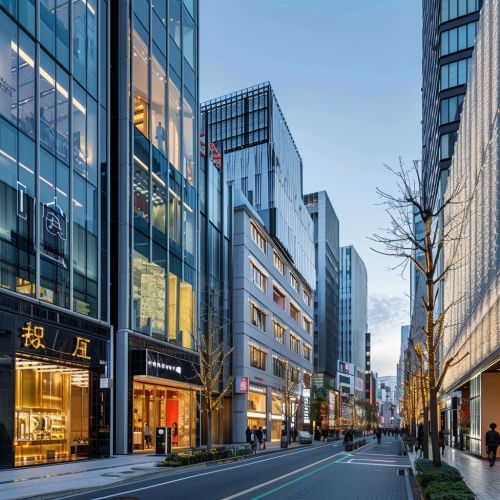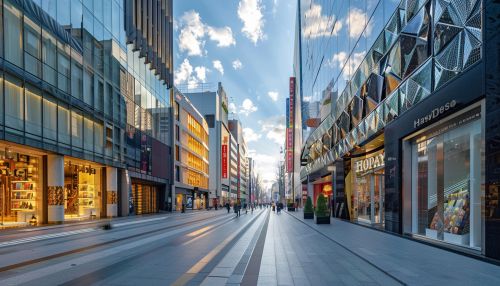Ginza
Overview
Ginza (銀座) is a district in Chūō, Tokyo, Japan, known for its upscale shopping, dining, and entertainment. It is one of the most luxurious shopping districts in the world, featuring numerous department stores, boutiques, art galleries, restaurants, nightclubs, and cafes. Ginza is also a significant cultural and historical area, with a rich history dating back to the Edo period.
History
Edo Period
Ginza's history dates back to the early Edo period (1603-1868), when it was established as a silver coin mint. The name "Ginza" itself means "silver mint" in Japanese. The area was initially developed in 1612, when Tokugawa Ieyasu, the founder of the Tokugawa shogunate, ordered the construction of the silver mint. This mint was responsible for producing silver coins, which were a crucial part of the economy during the Edo period.
Meiji Restoration
During the Meiji Restoration (1868-1912), Ginza underwent significant modernization. The government aimed to transform Tokyo into a modern metropolis, and Ginza was chosen as a model of Western-style urban planning. In 1872, a devastating fire destroyed much of the area, providing an opportunity for redevelopment. The new Ginza was designed with wide, Western-style streets and brick buildings, a stark contrast to the traditional wooden structures that characterized much of Tokyo at the time.
Taishō and Shōwa Periods
Ginza continued to evolve during the Taishō (1912-1926) and Shōwa (1926-1989) periods. The area became a symbol of modernity and luxury, attracting high-end retailers and affluent customers. The iconic Wako building, with its distinctive clock tower, was completed in 1932 and remains a landmark of the district.
Post-War Era
After World War II, Ginza quickly recovered and reestablished itself as a premier shopping and entertainment district. The post-war economic boom in Japan led to increased consumer spending, and Ginza became synonymous with luxury and sophistication. The district's reputation continued to grow, attracting international brands and tourists from around the world.
Architecture
Ginza is renowned for its eclectic mix of architectural styles, ranging from traditional Japanese to modernist and contemporary designs. The district features several notable buildings, each contributing to its unique urban landscape.
Wako Building
The Wako building, completed in 1932, is one of Ginza's most recognizable landmarks. Designed by architect Jin Watanabe, the building features a neoclassical style with a prominent clock tower. It houses the Wako department store, known for its luxury goods and high-end products.


Mikimoto Ginza 2
The Mikimoto Ginza 2 building, designed by architect Toyo Ito, is another architectural highlight. Completed in 2005, the building's façade features irregularly shaped windows, creating a distinctive and modern appearance. It houses the flagship store of Mikimoto, a renowned Japanese pearl company.
Ginza Place
Ginza Place, completed in 2016, is a contemporary building designed by Klein Dytham Architecture. The building's façade is made of aluminum panels arranged in a lattice pattern, giving it a futuristic look. Ginza Place houses several high-end retailers and restaurants, as well as a Nissan showroom.
Shopping and Retail
Ginza is a shopper's paradise, offering a wide range of high-end retail options. The district is home to numerous department stores, luxury boutiques, and flagship stores of international brands.
Department Stores
Ginza features several iconic department stores, each offering a unique shopping experience.
Mitsukoshi
Mitsukoshi, founded in 1673, is one of Japan's oldest and most prestigious department stores. The Ginza branch, located on Chuo-dori, offers a wide range of luxury goods, including fashion, cosmetics, and gourmet food.
Matsuya
Matsuya Ginza, established in 1925, is another prominent department store in the district. It offers a variety of high-end products, from fashion and accessories to home goods and gourmet food.
Luxury Boutiques
Ginza is home to numerous luxury boutiques, featuring both Japanese and international brands. Notable boutiques include Chanel, Louis Vuitton, and Dior, each offering exclusive products and personalized services.
Flagship Stores
Several international brands have chosen Ginza as the location for their flagship stores in Japan. These stores often feature unique designs and exclusive products not available elsewhere. Examples include the Apple Store, Uniqlo, and Zara.
Dining and Entertainment
Ginza offers a diverse range of dining and entertainment options, catering to various tastes and preferences.
Fine Dining
Ginza is renowned for its fine dining establishments, many of which have been awarded Michelin stars. The district offers a variety of cuisines, including traditional Japanese, French, Italian, and Chinese.
Sukiyabashi Jiro
Sukiyabashi Jiro, a world-famous sushi restaurant, is located in Ginza. Founded by Jiro Ono, the restaurant has been awarded three Michelin stars and is known for its exceptional sushi and meticulous preparation.
L'Osier
L'Osier is a renowned French restaurant in Ginza, offering exquisite French cuisine in an elegant setting. The restaurant has also been awarded three Michelin stars and is known for its impeccable service and attention to detail.
Casual Dining
In addition to fine dining, Ginza offers a variety of casual dining options, including cafes, izakayas, and ramen shops. These establishments provide a more relaxed atmosphere while still offering high-quality food and service.
Nightlife
Ginza's nightlife is vibrant and diverse, with numerous bars, nightclubs, and lounges. The district offers a range of options, from sophisticated cocktail bars to lively nightclubs, catering to different tastes and preferences.
Cultural Attractions
Ginza is not only a shopping and dining destination but also a cultural hub, offering various attractions and activities.
Kabuki-za Theatre
The Kabuki-za Theatre, located in Ginza, is one of the most famous kabuki theaters in Japan. The theater hosts regular performances of kabuki, a traditional Japanese performing art known for its elaborate costumes and dramatic storytelling.
Art Galleries
Ginza is home to several art galleries, showcasing both contemporary and traditional Japanese art. Notable galleries include the Shiseido Gallery, which features contemporary art exhibitions, and the Ginza Graphic Gallery, which focuses on graphic design and visual arts.
Hibiya Park
Hibiya Park, located near Ginza, is a large public park offering a peaceful retreat from the bustling city. The park features beautiful gardens, walking paths, and several historical monuments.
Transportation
Ginza is well-connected by public transportation, making it easily accessible from various parts of Tokyo.
Subway
Ginza is served by several subway lines, including the Tokyo Metro Ginza Line, Hibiya Line, and Marunouchi Line. The Ginza Station is a major hub, providing convenient access to the district.
JR Lines
The JR Yamanote Line and Keihin-Tohoku Line serve the nearby Yurakucho Station, providing additional access to Ginza.
Bus
Several bus routes pass through Ginza, offering an alternative mode of transportation for visitors.
Economy
Ginza plays a significant role in Tokyo's economy, contributing to its status as a global financial center. The district's high-end retail and dining establishments attract affluent customers and tourists, generating substantial revenue.
Real Estate
Real estate in Ginza is among the most expensive in Tokyo, reflecting the district's desirability and prestige. The high demand for commercial and residential properties drives up prices, making it a lucrative market for investors.
Tourism
Ginza is a major tourist destination, attracting visitors from around the world. The district's luxury shopping, dining, and cultural attractions make it a popular choice for tourists seeking a sophisticated and upscale experience.
Future Developments
Ginza continues to evolve, with several ongoing and planned developments aimed at enhancing its appeal and infrastructure.
Urban Renewal Projects
Several urban renewal projects are underway in Ginza, focusing on modernizing buildings and improving public spaces. These projects aim to preserve the district's historical charm while incorporating contemporary design elements.
Sustainable Development
Sustainability is a key focus in Ginza's future development plans. Efforts are being made to incorporate green building practices, improve energy efficiency, and enhance public transportation options to reduce the district's environmental impact.
